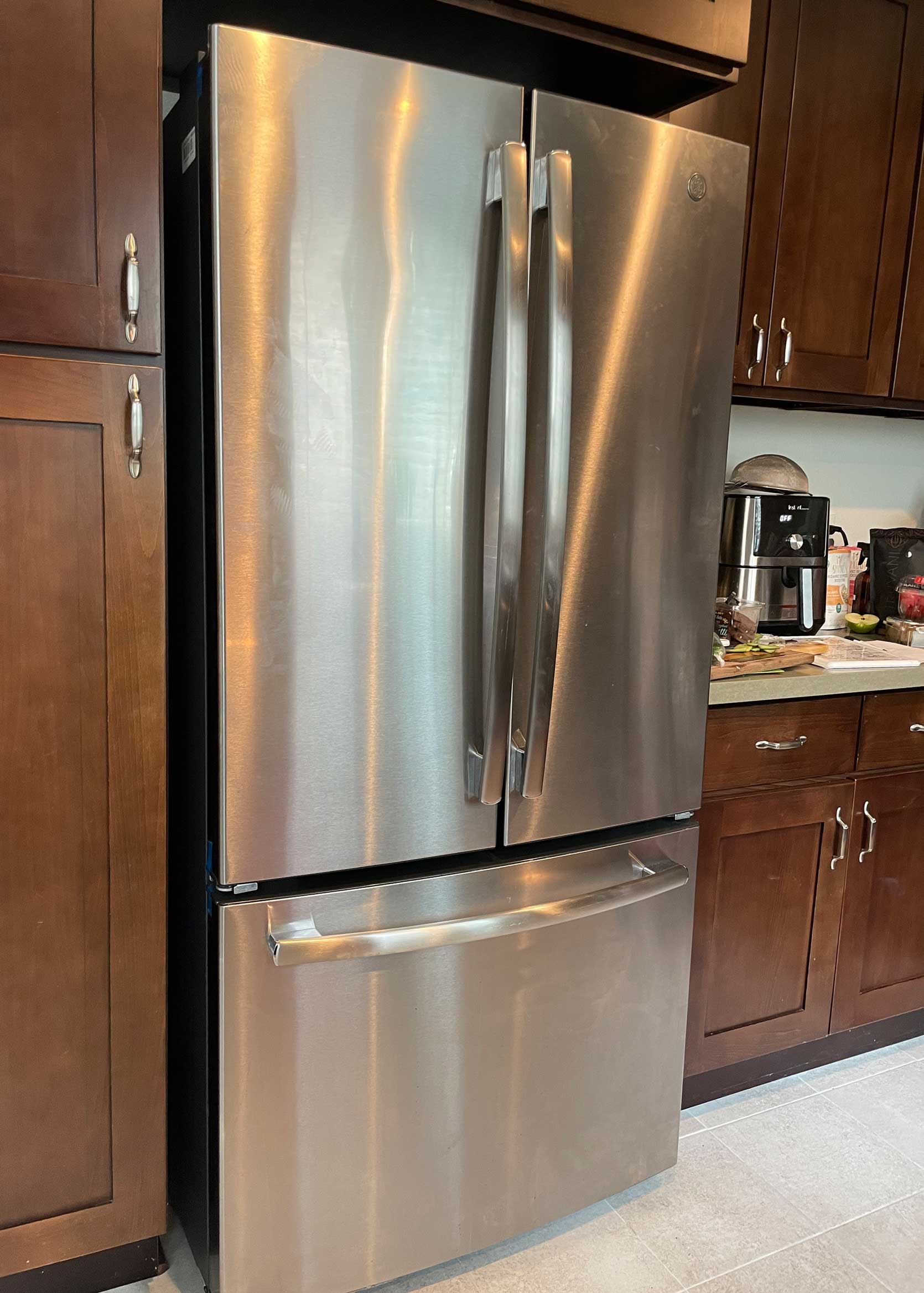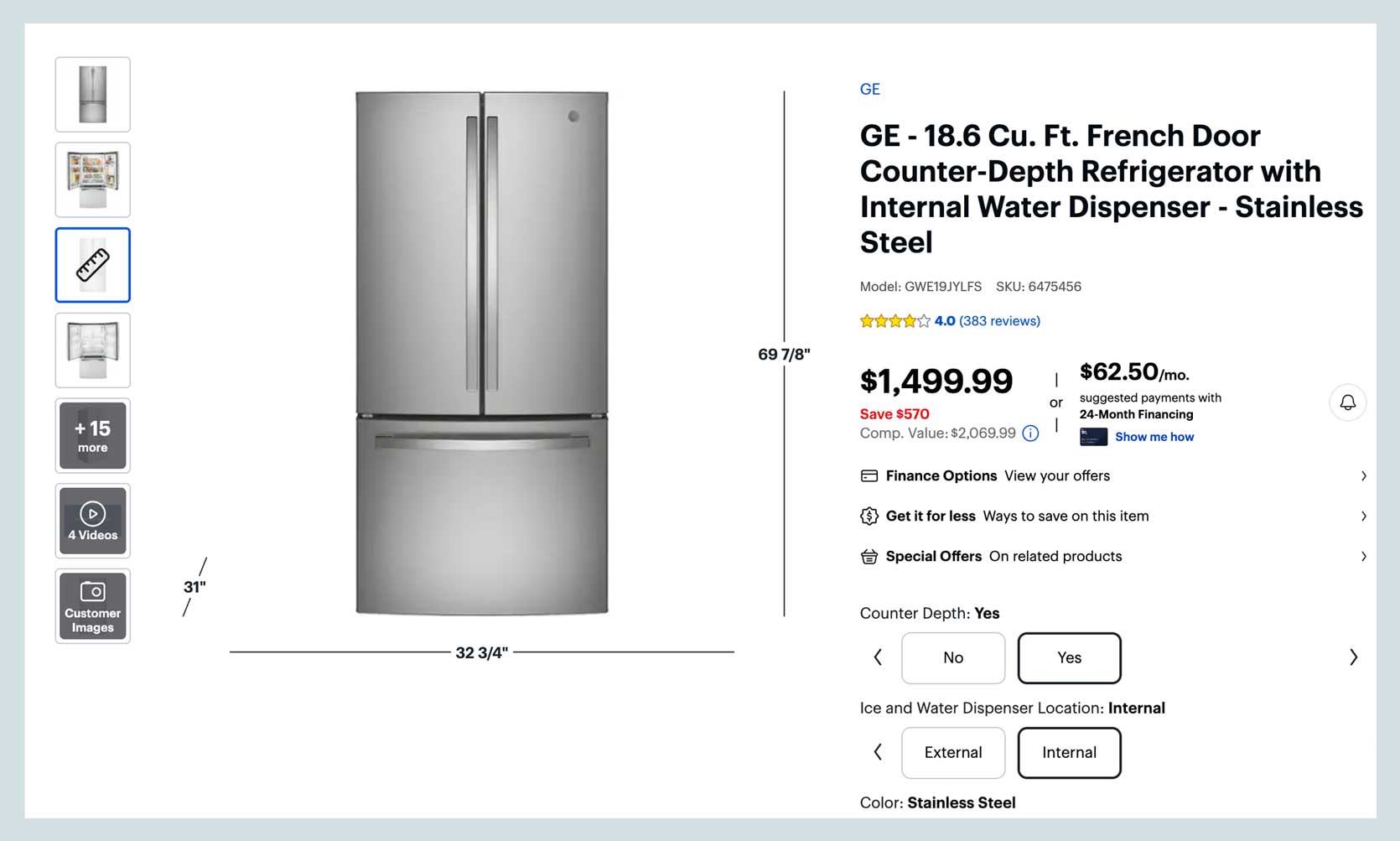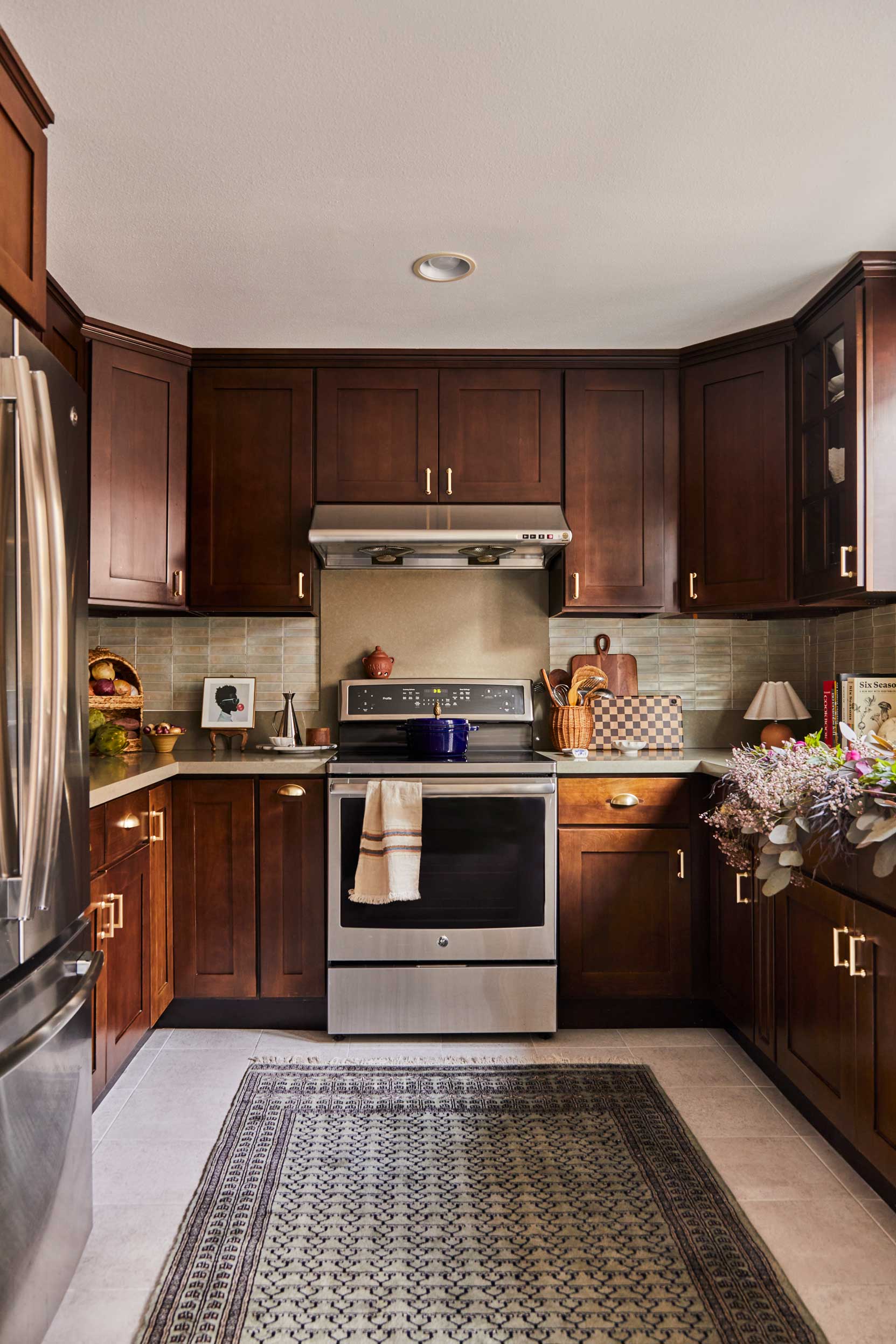Two years ago, right around this time, I revealed my rental kitchen refresh. During the months that preceded that, I chronicled my journey in getting from “before” to “after,” and one of the major overhauls was of my appliances. When my family moved in, we had a partially broken white electric-coil range, a black (and ancient) dishwasher, and a very small, apartment-style fridge, also in white. It was a mishmash of finishes and not a single one of those appliances suited our needs.
It took me nearly a full year to hunt down new-to-me, secondhand kitchen appliances in my budget, but I finally did. The biggest get was my refrigerator, mostly because I had very specific limits, including needing a counter-depth model. Not just that, but the way our countertops were cut with a slight overhang in the area where the fridge lived meant we couldn’t accommodate a standard 36-inch width model either. We needed a counter-depth fridge.
Here’s a little excerpt from my kitchen reveal about this process:
“Let me tell you…finding a 33-inch fridge in counter-depth (this space required that) was near IMPOSSIBLE. I’m not exaggerating when I say they make three models that fit that bill. ON THE ENTIRE MARKET. And then to try to find one of those secondhand, well, Everest territory. BUT I DID IT. And the rush of exhilaration I felt is what I imagine stockbrokers feel when they do stockbroker things that make them a lot of money. I love our fridge…it makes me quite happy every day.”
So, here I am, 700-plus days later…do I still love it? Am I still quite happy every day? Well, mostly, though it’s complicated. And that’s what I’m here to talk about today.


What Is A Counter-Depth Fridge, & Why Does Someone Need (Or Want) One?
A counter-depth refrigerator is exactly what it sounds like: A fridge that is about as deep as a standard kitchen countertop, which typically ranges between 24 and 30 inches, while a standard depth fridge can be anywhere from 30 to 36 inches deep and extend past the countertops. So, why exactly does it matter, and why did I personally choose to go with counter-depth? Glad you asked.
I grew up in homes where there was a built-in cabinet box that accommodated a standard-depth refrigerator. That looks like this:
Our fridges sat nicely inside a frame made for their depth, with upper cabinetry that also extended out further than the rest of the uppers. We had a decent amount of space to move around the fridge, as well. Some people (or mainly, designers) don’t love this because it breaks from having a seamless line. You can see that in the above photo. It certainly doesn’t look bad when done well, in my opinion, but it’s become the norm lately to have a fridge, especially when integrated/panel-ready, that is flush with countertops and lower cabinetry.
A way around this, if you care, is to have your fridge on its own wall built into floor-to-ceiling cupboards without counter space, such as this:
None of these, of course, was my scenario. I was not renovating a custom kitchen. I was merely hoping to get my rental kitchen—where I spend a massive amount of time cooking, eating, or cleaning up—looking less “bargain basement bin” and more “nice family home.” As I mentioned at the beginning of this article, I was working around some limitations in terms of width, and after measuring, I realized that a standard-depth would stick out almost 10 inches past my countertops. In a tight U-shaped kitchen such as mine, an appliance that projects that far into the center space is both an eyesore but also cuts off physical and visual flow. I know I would have to be searching for something counter-depth due to the placement of where my fridge was in the floor plan.
I found this great side-by-side comparison on Instagram of the different (note: this is not in my kitchen) to get a sense of how much further a standard-depth sticks out:
My Fridge Specs, Where I Bought It & What I Paid For It
This post isn’t meant to be some kind of ringing endorsement for the refrigerator we ended up getting, but I wanted to include it in case it was useful to anyone, and also because I wanted to show how much of a difference a few inches in depth can make to the interior of a fridge. Here is the model I ended up buying (reminder: I bought mine used on Facebook Marketplace for around $600).

Below is the same fridge, but instead of being 31 inches deep, it’s 37.5 inches deep. (Keep in mind that the fridge itself is 36 inches, but the final dimensions include the handles, as well.) A six-inch difference equates to nearly six cubic feet of difference. That, my friends, is a lot of space inside a fridge. Also, note that the smaller counter-depth model is $100 more expensive than the regular fridge. From what I understand, that increase in price is mostly due in part to supply and demand (they simply make fewer counter-depth fridges than standard depth), but also because the cost to produce them is higher.

These are important things to keep in mind if you are considering something counter-depth, but more on my personal experience with the diminished space, in particular, below. Keep reading!
My Honest Thoughts, 2 Years Later.
There are a lot of pros about our fridge, but also some cons. Let’s start with the positives, because I’m an optimist.
Pros:
- It fits! Above and beyond, that was my number one priority, obviously.
- It doesn’t stick out an additional six inches into my already tight kitchen!
- Aside from the aesthetics of its size, by far the most convenient part about a counter-depth fridge is that, because it isn’t as deep, food doesn’t get lost in the caverns of your chiller. Playing jar Jenga is wildly overstimulating to me, pulling pickles, pasta sauce, and relish out of the way just to get to the kalamata olives alllll the way in the back. My fridge has the capacity to nest things only two to three times before you hit the back wall. To some, this might be a con, because it limits storage, but to someone like me, who often has containers of leftovers to contend with (and needs constant reminders that yes, I have food at home), it limits food waste significantly.

From where I was coming (the basic top-freezer model loved by landlords for its price tag), the fridge is a huge upgrade, whether it was counter depth or not. A lot of what I loved about it to begin with can be attributed to this, as well as the French-door design. I loved having easy access to all the space on the interior side of the door, the wide deli drawer, and adjustable shelves.
Cons:
- Fewer model options to choose from. This was one of my biggest challenges, especially because I needed both a counter depth as well as only 33 inches in width (36 inches in width and depth is standard). These are becoming more popular, thankfully, so supply increases as does demand.
- They are more expensive, as I already mentioned.
- Decreased cubic storage. You can also expect a counter-depth refrigerator to have a capacity of anywhere from 17 to 25 cubic feet (LG makes some with really maximized interiors), with an average of around 22 cubic feet. A standard refrigerator houses around 20 to 30 cubic feet, depending on style, model, and width.
Now that I’ve lived with this fridge in this size for over two years, I can say that I have been frustrated at times with simply not having enough room. We are a family of two adults and one young child, and it’s barely enough room for all my groceries. I usually go shopping for the week and shove things in with a hope and a prayer. Granted, I buy enough groceries to cover breakfast, lunch, dinner, and snacks for at least six days’ worth of eating. Plus, we keep our large water pitcher in there because there is no water line to that side of the kitchen, so the water dispenser doesn’t work, and I need cold water to survive. If you’re the type of person who only buys groceries for a few meals a week, there’s only one or two of you, or you’re more minimal than I am in terms of your condiments, milks/drinks, or produce, it may be just fine for you.
In a future kitchen of my choosing, this size will simply not cut it for my cooking style. I’m sure it would feel better in a full 36-inch width, but even then, even with the “pro” of not losing food in the back of the fridge and having things more accessible, I’d probably choose the largest fridge I could find as long as it made sense for the footprint of my space.
—
That is my assessment, but this is a community where all of your opinions are so valued (and varied), so please chime in in the comments below with your own experiences related to a counter-depth fridge, for better or for worse.
Until next time, friends…
Opening Image Credits: Photo by Sara Ligorria-Tramp | From: Mountain House Kitchen Reveal
